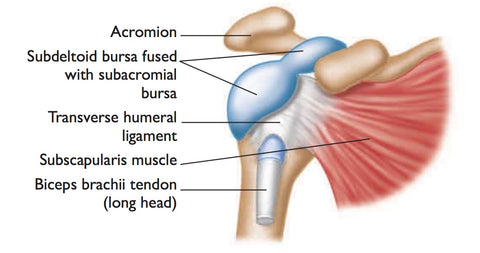Posted by Judith Winer on Nov 02, 2016

Failure to attend to shoulder bursitis often results in a worsening of the condition
Shoulder bursitis is not generally an isolated condition but is usually associated with a rotator cuff tear or impingement syndrome.
The subacromial bursa is the largest and most commonly injured bursa in the shoulder region.
Bursitis may be caused by a combination of factors including rotator cuff dysfunction, instability in the joints of the pectoral girdle, osteoarthritis, postural misalignments, bone spurs and anything that decreases space in the limited subacromial space.
Common Cause of injury
Overuse from throwing activities, tennis, swimming or baseball. Falling onto an outstretched arm. Local infection.
Signs and symptoms
Pain in the shoulder, particularly when raising the arm. Pain on lying on or compressing the injured shoulder. Loss of strength and limited motion of the shoulder.
Complications if left unattended
Failure to attend to shoulder bursitis generally results in a worsening of the condition, a further thickening of tendons and bursa(e) leading to increased inflammation and pain.
The client runs the risk of developing a chronic condition, as well as a danger that the fluid in the bursa(e) becomes infected, a potentially more serious situation sometimes necessitating surgery.
Immediate treatment
Discontinue all activity causing inflammation of the shoulder. RICER regimen and analgesics to reduce inflammation and pain. Then heat to promote blood flow and healing.
Rehabilitation and prevention
The client should avoid pressure to the injured shoulder and inflamed bursa(e) during recovery as well as any activities likely to irritate the condition. Begin exercising the shoulder when instructed by a healthcare professional in order to restore strength and shoulder mobility.
Warming-up and cooling-down exercises, with an emphasis on stretching, strength training and maintaining looseness in the shoulder can help prevent bursitis from developing.
Long-term prognosis
Shoulder bursitis tends to ease with proper healing and minor rehabilitation, and a full recovery to activity can usually be expected, particularly if no infection of the bursa is present. In some cases, aspiration of bursal fluid by needle is recommended to reduce inflammation and ensure no infection is present.
Trigger Points
Latent trigger points in the shoulder muscles (rotator cuff) may be part of the cause of the initial injury as trigger points make their host muscles shorter, weaker, and less efficient. Compensatory factors come into play which cause additional strain on other muscles.
In almost cases of shoulder injury, trigger point activity will likely increase in what many believe to be a key element in the body's natural protect and defend mechanism.
These trigger points will need to be identified and treated as part of the rahabilitation program, and also to help avoid re-occurrence or the development of other related complications to the shoulder unit.
Note: Trigger points in the teres minor muscle mainly cause a deep pain in the shoulder which can sometimes be misinterpreted as bursitis.
Комментариев нет:
Отправить комментарий